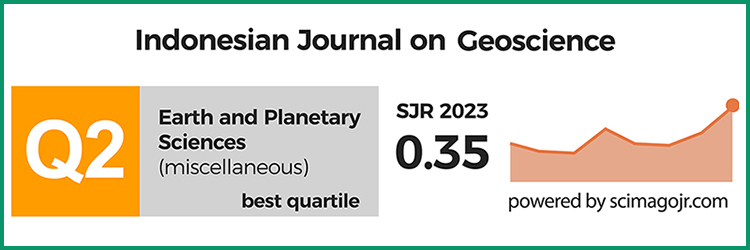Geothermal System as the Cause of the 1979 Landslide Tsunami in Lembata Island, Indonesia
DOI:
https://doi.org/10.17014/ijog.2.2.91-99Keywords:
Lembata Island, landslide, sample analysis, clay minerals, geothermal systemAbstract
DOI:10.17014/ijog.2.2.91-99
A tsunami landslide which caused hundreds casualties and lots of damage took place on Lembata Island in 1979. In order to understand the characteristics of the landslide mechanism, a field survey was conducted in 2013 which sampled both the origin soil and landslide material, and the water from hotspring around the landslide site. The physical properties of the soil obtained show that the original soil has dominantly coarser grain than the landslide material (80.5% coarser grain compared to 11.8% coarse grain respectively) which indicates that the soil has become finer and softer. Hot spring analysis indicated that the mineral content of the water was 99.48% SO4. This shows that magmatism processes are involved which caused the soil to become acidic and may have fragilised the system. Results of X-ray Diffraction Mineralogy Analysis (XRD) show that the original soil is composed of minerals of cristobalite, quartz, and albite, while the landslide material consists of clay minerals such as quartz, saponite, chabazite, silicon oxide, and coesite which are typical minerals in a hydrothermal environment. Based on these results, it can be concluded that the area was influenced by an active geothermal system that could be the main source mechanism behind this disastrous event.
References
Arif, A., 2010. Jurnalisme Bencana - Bencana Jurnalisme: Kesaksian dari tanah bencana. Gramedia Popular, 238pp.
CVGHM (Center for Volcanological and Geological Hazard Mitigation), 2013. Eruptive Volcano History. https://www.volcano.si.edu/
Geological Agency, 2014. X-ray Diffraction Mineral analysis. Internal report.
Hadian, R., Sudradjat A., and Elifas, J. J., 1979. Laporan Singkat Pemeriksaan Ili Werung Bulan Juli 1979. Internal publication, Volcanological Survey of Indonesia.
Inoue, A., 1995. Formation of clay minerals in hydrothermal environments. Origin and Mineralogy of Clays. Springer, p.268-329.
Iryanto, 1980. Pemeriksaan G. Sirung, G. Ili Werung dan G. Hobal di Nusa Tenggara Timur, Bulan Oktober 1980”. Volcanological Survey of Indonesia.
Koesoemadinata, S. and Noya, Y., 1990. Geology of the Lomblen Quadrangle, East Nusa Tenggara. Geological Agency, Indonesia.
Lamanepa, F., 2013. Larantuka, hujan deras, dan banjir 1979. https://franklamanepa.blogspot.com/2013/12/larantuka-deras-danbanjir-1979.html.
Lassa, J., 2009. Bencana yang terlupakan? Mengingat kembali bencana Larantuka dan Lembata 1979-2009”. Journal of NTT Studies. USGS (United State of Geological Survey), 2013.
The Preliminary Determination of Epicenters (PDE) Bulletin 1976-2013. Online source of https://www.https://earthquake.usgs.gov/data/pde.php.
Yudhicara, Hidayati, S., and Suparan R., 2013. “Laporan Penyelidikan Tsunamigenik di Pulau Lembata, Nusa Tenggara Timur”. Internal report of Center for Volcanology and Geological Hazard Mitigation, Geological Agency.



















